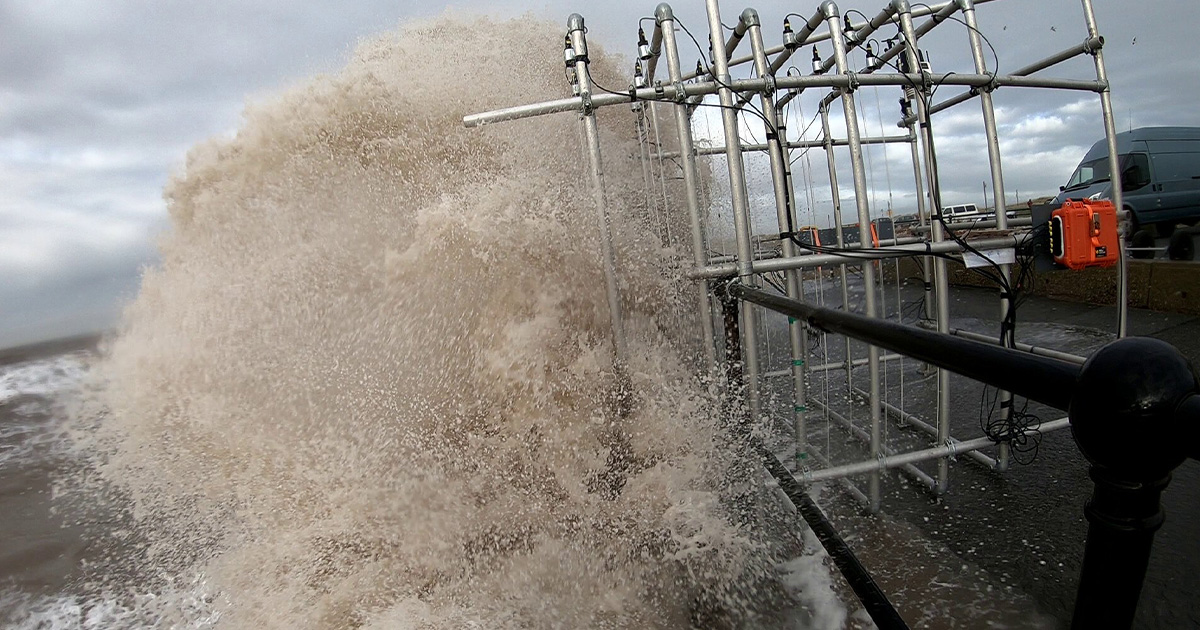The National Oceanography Centre (NOC) has developed WireWall, which is the first system that can measure the speed and volume of overtopping water on a wave-by-wave basis in the field. The ability to measure overtopping will ultimately reduce uncertainty in overtopping forecasts and improve hazard warning systems.
Previous field data has been obtained using large collection tanks, which can only be deployed for short periods and are only capable of obtaining data on the total volume of water that has overtopped during a storm or a high tide event. The tanks used in previous field measurements can only be deployed on a few types of structures, such as inland of a solid wall at the top of coastal defense, which means that the amount of data previously obtained in the field is very limited—compared to WireWall which has been designed so that it can be deployed on almost any structure.
Until now, a lack of field data has meant that the prediction tools currently used are based on studies of a limited range of coastal defenses using idealized experiments in flumes. This means that the industry standard tools that are used to predict wave overtopping can have large uncertainties.
A paper published in the Communications Engineering Journal highlights the validation of WireWall, and several of the results from the first trial deployments at Crosby, near Liverpool. The validation process took place in the flume facilities of the project partners at HR Wallingford, where a wave machine-generated waves similar to those that might be expected at Crosby, and these impacted a 1:7.5 scale model of the Crosby seawall.
 The cumulative volume of overtopping water was measured during one of the Crosby deployments. The colored lines are measurements from WireWall, at different distances inland. The thick black line is the estimate from the industry-standard tool Bayonet GPE (based on EurOtop), and the dashed and dotted black lines show the +/- 1 and +/- 2 standard deviations of the uncertainty in Bayonet GPE. (Image credit: The NOC)
The cumulative volume of overtopping water was measured during one of the Crosby deployments. The colored lines are measurements from WireWall, at different distances inland. The thick black line is the estimate from the industry-standard tool Bayonet GPE (based on EurOtop), and the dashed and dotted black lines show the +/- 1 and +/- 2 standard deviations of the uncertainty in Bayonet GPE. (Image credit: The NOC)
Following the flume tests, the team undertook a series of preliminary trial deployments of WireWall at Crosby in the winter of 2018/19. Eight short, single-tide deployments were made, and overtopping occurred during 4 of these—even this relatively small amount of data was sufficient to show the experts that three-quarters of the water came over before high tide, which was not expected. The total amount of water that came over would not be classed as hazardous, even to a person walking on the promenade, but because the system measures the water from every individual wave that comes over, the team can show that some of the biggest waves were a hazard not just to people but to vehicles as well. Dr. Jennifer Brown, Principal Investigator of the WireWall project, said: "Being able to measure overtopping on a wave-by-wave basis means we can examine the nature of the overtopping in much more detail than has previously been possible.”
In the future, WireWall overtopping measurements could be used to improve industry-standard overtopping prediction tools and hence improve flood and hazard forecasts. Field measurements of overtopping will also allow experts to study the sort of wind and wave conditions that cause overtopping, which will improve numerical models.
The WireWall project was funded by the Natural Environment Research Council (NERC) program ‘Innovative Monitoring Approaches’. A follow-on project, Coastal REsistance: Alerts and Monitoring Technologies (CreamT), is underway, funded by NERC's Digital Environment program.
To find out more about WireWall, please visit: https://coastalmonitoring.org/ccoresources/wirewall/
To read the paper, please visit: https://www.nature.com/articles/s44172-023-00058-3



